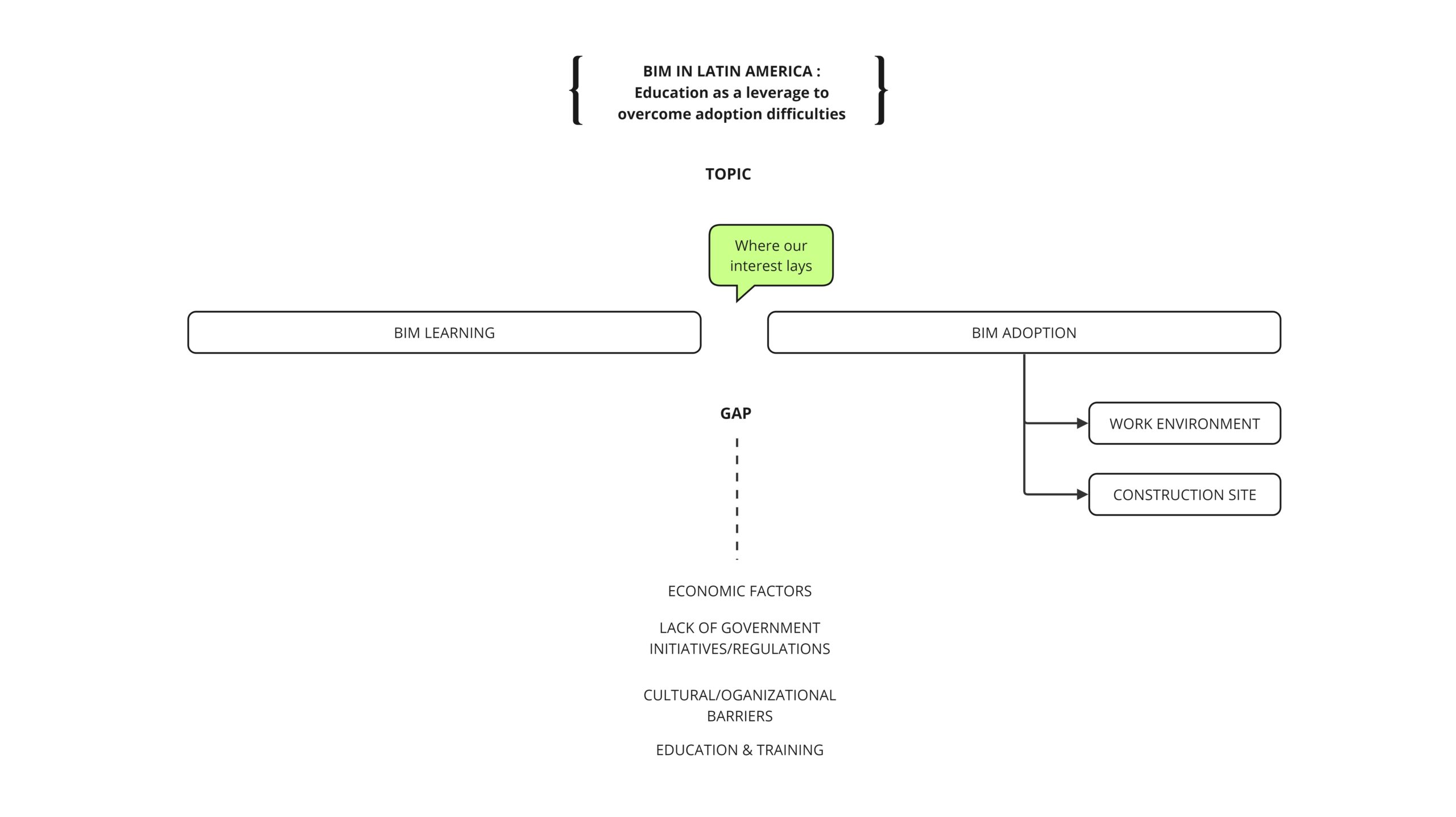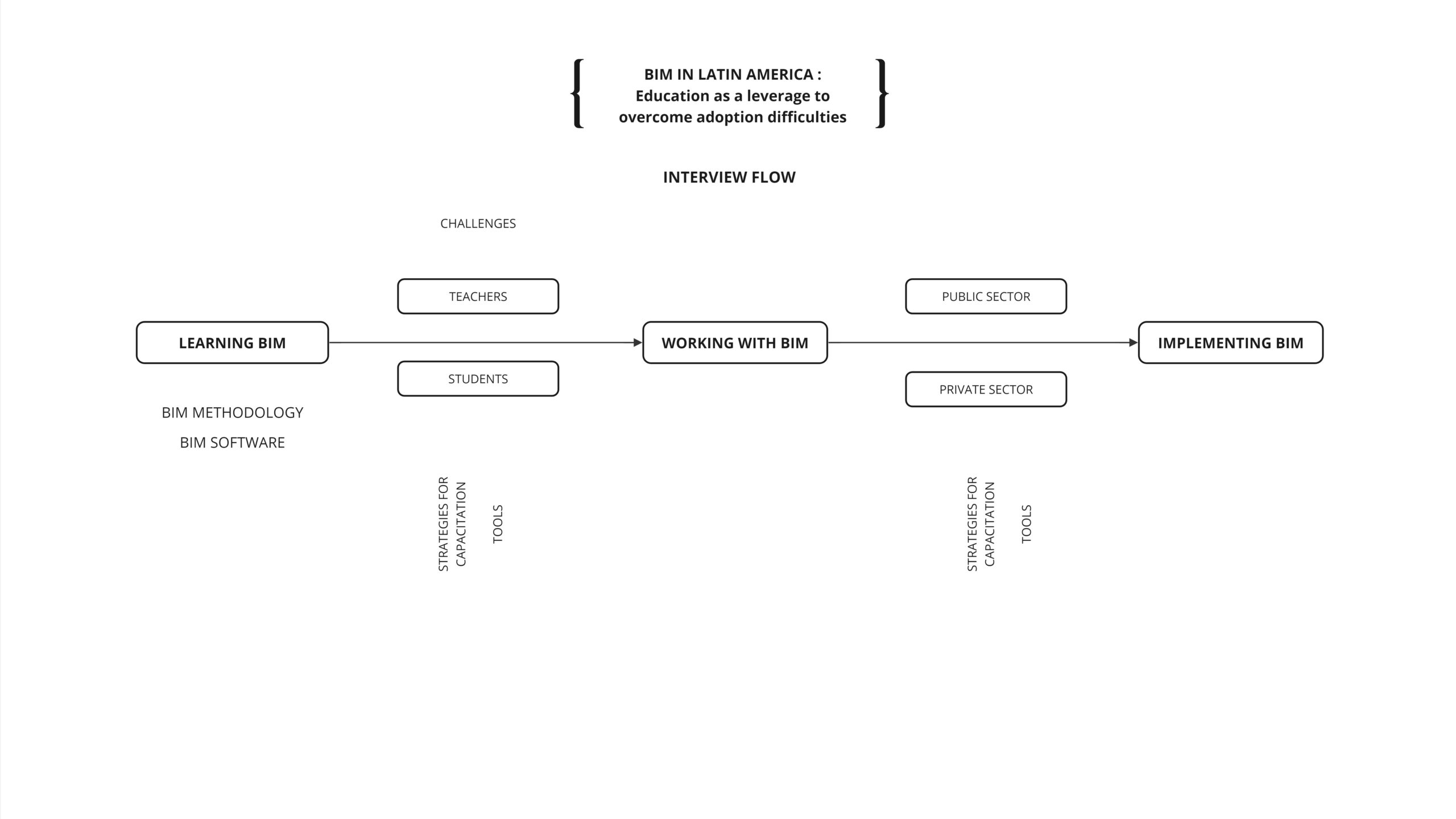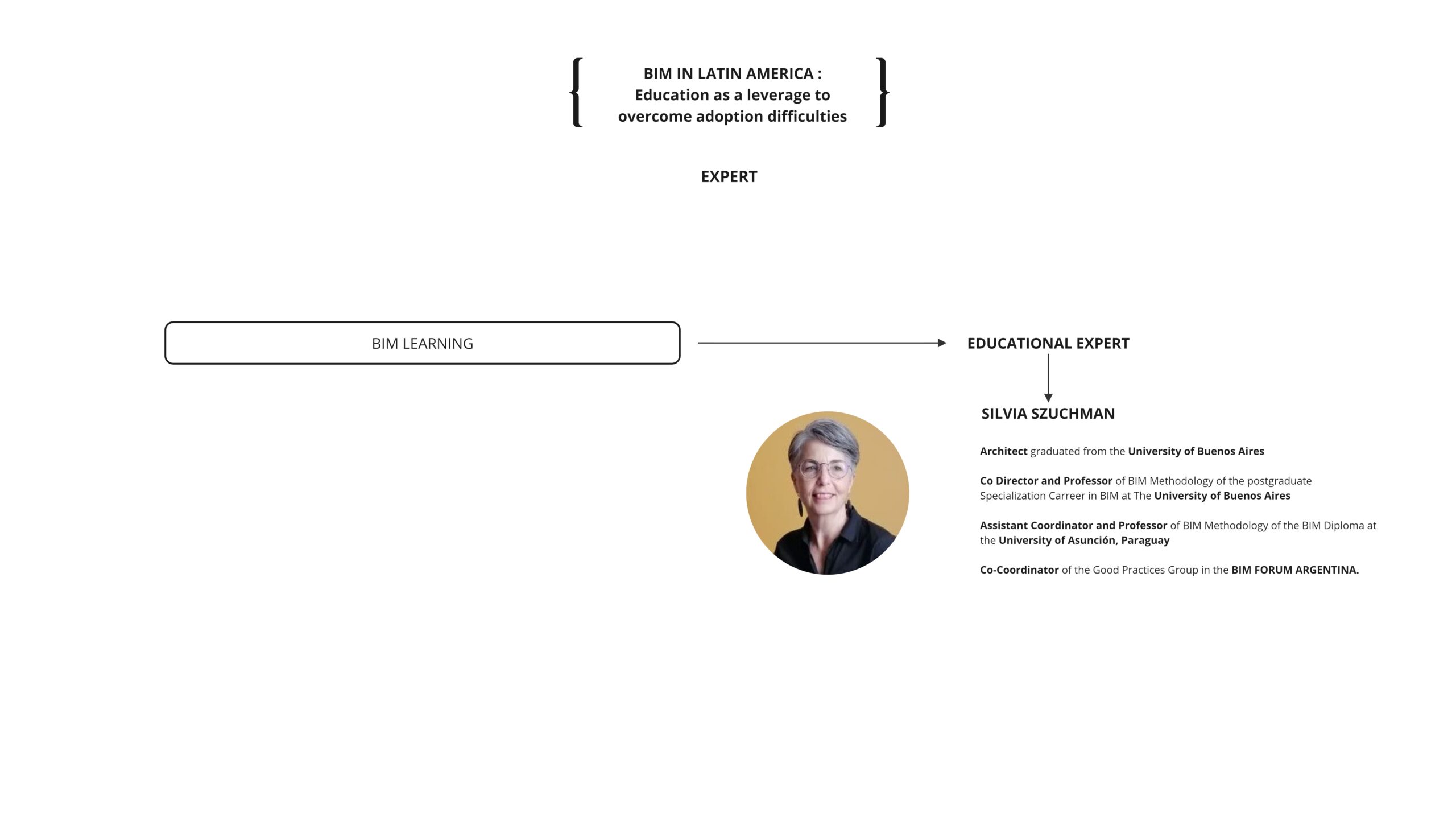BIM software is reshaping architecture, engineering, and construction globally, but its adoption is uneven. Many regions, including Latin America, lag behind in implementing this technology. Factors such as the economy, insufficient education and training, cultural and organizational barriers, lack of regulations or government initiatives are accountable for this issue. Additionally, the limited enhancements primarily focus on large-scale construction rather than addressing issues at the smaller scale. A gap exists between the learning phase and

There is a clear linear relationship between education, the work environment, and the construction stage, and we recognize education as the optimal solution for addressing implementation challenges.

Alongside an educational field expert, Silvia Szuchman, we plan to delve into key aspects such as the way BIM is being addressed in universities and, in a later stage, how the transition from learning to professional life occurs, and what the process of implementation in the professional sphere is like. By this means, we aim to identify strategies and means to facilitate and accelerate the complete implementation of BIM in Latin America.
Silvia is an architect graduated from the University of Buenos Aires
Co Director and Professor of BIM Methodology of the postgraduate Specialization Carreer in BIM at The University of Buenos Aires
Assistant Coordinator and Professor of BIM Methodology of the BIM Diploma at the University of Asunción, Paraguay
Co-Coordinator of the Good Practices Group in the BIM FORUM ARGENTINA.

The interview flow addresses first the education phase, then proffessional life, and later, implementation:
Education
Regarding the evolution of BIM, a steady growth in Argentina is observed, with increasing familiarity and interest among professionals. Examples of BIM implementation in both the public and private sectors, including government initiatives such as the BIM LATAM Network, are highlighted. Despite progress, confusion between parametric modeling and full BIM implementation is noted as a significant challenge that requires addressing collaborative work processes and information management.
When discussing the challenges that implementation face in Latin America, a multiplicity of factors including economic constraints, educational barriers, and cultural differences arise and the importance of government support, legislation, and the integration of BIM into public works to accelerate adoption is stressed. Addressing the educational picture first, the concept of methodology in BIM comes up first.
Silvia explains how students need to learn to process data in a way that every actor involved in the facility in any of its phases (project, construction, operation and decommission) can understand, manipulate and save it in a secure fashion to avoid misrepresentations or loss of information. It also helps set the scope of the work required in clear terms to both parties involved. In conclusion, understanding data management cycles and structured communication are fundamental skills for future professionals in the AEC industry, with emphasis placed on the core principles of BIM methodology.
However, students are not the only ones requiring education in order to enable the transformation process. Exposure to BIM methodology varies across generations and many participants in the educational sphere have not been formed, slowing down this process.
“Implementing BIM methodology can and should involve individuals with practical and technical expertise, even if they lack modeling proficiency.” This broadens the impact of implementation across all participants in the AEC field. Despite varying levels of familiarity with BIM software, individuals are generally comfortable with 3D concepts and simulations. Understanding the underlying structure of processed information enables participation in collaborative tasks, such as studying spaces, analyzing data, and contributing expertise to the team.
Professional life & Implementation
Moving on from training during the grade career, we delve into the educational possibilities and how individual training is promoted. BIM is mostly learnt as a postgraduate course, or in private institutes. However, we are keen on knowing what happens after. Iniciatives such as SiBIM started in 2018 at the Ministry of Public Works to plan the implementation of BIM in the public sector and offer information, guidelines and other documents that the public sector should follow, aiming to serve and benefit not only the public, but the private sector too. These are public documents of free access to whomever requires them. Moreover, some f the public sector groups in the REDGOB LATAM have educational aspects that the interested professionals can access. A leading example has been Plan BIM Chile that offers not only documents but tutorial videos on different topics in its site.
Private sectors like the different BIM FORUMS in each country also have publications that can help.
Despite all these available tools, individual learning initiatives stay halway if not backed-up by a greater institution. Financing education and training differs in the public and private sector. Public or big private institutions have greater financial instruments to capacitate their staff members, while small don’t, which derives in workers being responsible of their own capacitation, financially, and time-wise. For this later case, professional councils or societies sponsor actualization courses or there are even private groups that sponsor BIM like the BFA (Bim Forum Argentina), which provide work groups in different aspects of BIM implementation to join.
As the Co-Coordinator of the Good Practices Group in the BIM FORUM Argentina, Silvia has contributed to the creation of BIMDocs, a curated repository of BIM documents to advance knowledge and implementation. BIMDOCS facilitates the transition from education to the professional environment by providing a comprehensive repository that aggregates information from various countries and institutions. Organized by source, region, language, type of document, and level of difficulty, it offers individuals the opportunity to easily access relevant resources to enhance their knowledge and skills. Moreover, it suggests related documents, enabling users to explore interconnected topics and deepen their understanding. Whether accessed individually or utilized collectively, BIMDOCS empowers professionals to swiftly integrate new strategies and knowledge into their practices, addressing a key challenge faced by individuals in the industry.
Considering the promising statistics revealed by the latest surveys in Latin America, which suggest a substantial number of companies in the region are open to adopting BIM (Building Information Modeling), the role of education in facilitating the transition for small businesses and firms to BIM emerges as a pivotal focus area. Silvia suggests that existing educational programs have the capacity to integrate teachings on information management and methodological aspects of BIM alongside instrumental facets within their current curriculum. This integration would require only a broadening of the scope of the existing courses. This advancement not only pushes the widespread adoption of BIM but also ensures a more consistent transfer of knowledge. As one delves deeper into existing programs, you acquire the necessary expertise for designing, constructing, and operating facilities. With a cohesive framework for data collection and effortless toggling between perspectives and scales, a seamless connection across all facets is created. Such integration is particularly beneficial for businesses and firms at all levels, with smaller entities standing to gain the most. Often constrained by limited resources, they face challenges in promoting or financing ongoing training for their employees.
Conclusion
The interview concluded positively, with Silvia showcasing her impressive background and addressing all our queries effectively. Of particular interest was the distinction drawn between the concepts of BIM Methodology and Software, highlighting their complementary yet independent nature. This revelation broadened our perspective on BIM adoption, emphasizing its accessibility beyond software users to anyone with an interest in learning.
This insight served as a catalyst for our podcast discussion, offering a fresh angle on education in the realm of BIM implementation. Traditionally, our focus had been primarily on software usage in BIM education. However, the interview threw light on the vast potential for expanding educational horizons within this field, hinting at promising avenues for future exploration.
Keywords: LatAm – Education and training – implementation – Regulatory Frameworks – Technological Infrastructure – Industry Collaboration – inequality – accessibility

